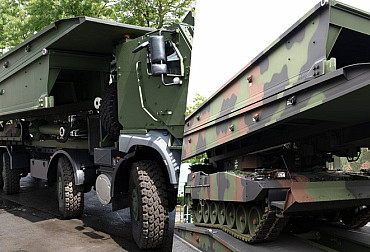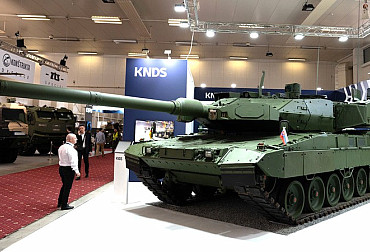Government Airbuses Provide an Air Bridge in Full Force after an Overhaul
The Czech transport air force is currently doing top work in supplying the country with scarce medical supplies. The Government Airbuses are constantly on alert to fly wherever necessary. Let's not forget that this was the first ACR aircraft to bring the much-needed coronavirus tests from China.

Picture: The Government Airbuses are constantly on alert to fly wherever necessary | GLOMEX MS
Not only have they recently transported this necessary medical material, but they also brought Czech citizens from abroad back to their homeland. Let's be glad that the planes are currently in full force. Thanks to the German company Lufthansa Technik, our government aircraft have gone through all the necessary service operations.

Picture: Aircraft in front of Lufthansa Technik AG hangar | GLOMEX MS
Had the Covid-19 pandemic struck a year earlier, we would have a serious logistical problem. In 2019, the Air Force underwent a large twelve-year inspection (12YE-Check) with both of the Airbus A-319CJ aircraft. The first check was completed in the technical facilities of the Lufthansa Technik company in Hamburg in winter, the second in summer. For each of the aircraft, this de facto meant an operational shutdown for several months. The aircraft was basically completely disassembled and after a thorough inspection and tests, it was returned to service. We bring you unique photos from behind the scenes of this demanding inspection, which were released specifically for this report.

Picture: A classic "mess" around the aircraft. You can see the amount of special equipment needed fpr work on the aircraft. SkyJack is a platform that allows the technician to work safely at the required height. | GLOMEX MS
Both aircraft were serviced by Lufthansa Technik AG. It has several huge VIP hangars in Hamburg, which allow repairs of several aircraft "under the roof" at once.
Almost 1000 tasks were performed on each aircraft, i.e. inspections of partial functionalities or technical units – for example, the engine or landing gear contains thousands of components that need to be checked.

Picture: Prior to mounting, the engine is placed on a special trolley, which is used for mounting and dismounting the engine and subsequent departure. A chain jack can be seen on the right. | GLOMEX MS
In total, several hundred thousand of components passed through the hands of the technicians. For 6 to 8 weeks, they work on aircraft in two shifts for a total of approximately 20,000 man-hours.

Picture: Engine from the side – notice the bags hanging in different places of the engine. They contain screws from the given place, so that there is no confusion. The reassembly of the engine (mechanical mounting) usually takes 4-5 hours. There is a precise procedure for tightening the screws, including tightening with torque wrenches. | GLOMEX MS
There are 10 to 15 people are working on the aircraft at the same time, and dozens more are performing inspections on dismantled components in other hangars, workrooms and laboratories. If a problem occurs, a night shift is called up.

Picture: View of the front – the open cover of the meteorological radar (so-called Radome), which detects the amount of water in the clouds in front of the aircraft. | GLOMEX MS
Fortunately, there are no delays in purchasing the spare parts (if needed), because Lufthansa Technik AG, as the leading Airbus service provider, can afford to keep parts in stock and have them immediately at hand.

Picture: A detailed view of air conditioning. Above, you can see through the floor into the passenger cabin. Otherwise, it functions as the storage space of the aircraft – the so-called Cargo Bay. At the bottom of the rails you can see rollers for easy movement of the containers. | GLOMEX MS
Nevertheless, just planning a 12YE-Check from the point of view of both the aircraft operator and the service provider is extremely demanding. It started more than a year in advance and was provided for the ACR by the Czech company GLOMEX MS.

Picture: View from the cargo area of the aircraft to the partition that separates the cargo area from the so-called Avionic Bay. The individual components of the electrical installation – navigation and communication devices – are inserted into the bases from the other side. | GLOMEX MS
Both the mandatory scope of inspections and other work required by the operator had to be planned in detail in advance. It is a pity that the Ministry of Defence did not have the resources for the already quite necessary replacement of the interior – it was dismantled during the inspection and it was returned clean, but it is still obsolete.

Picture: Disassembled interior lining, including seats and carpets. We see the technical installation and distribution system of oxygen supply. On the ground you can see the individual sections – toilet, bathroom, changing room – interior equipment of the cabin, which is not taken out. | GLOMEX MS
Let's remember that the 24th Air Transportation Base in Kbely together with Airbus provides not only the transport for the president and the government, but also for diplomatic delegations, soldiers on missions, transport of the wounded, the transport of repatriated citizens and humanitarian aid.

Picture: Cockpit with removed pilot seats | GLOMEX MS

Picture: Completely installed cabin, there can still be seen the plastic protective covers on the new carpets. | GLOMEX MS
The results of the twelve-year checks were finally verified by a final check and a test flight. Both Airbuses were thus ready for several more years of demanding service.

Picture: The Airbuses were thus ready for several more years of demanding service | GLOMEX MS





















